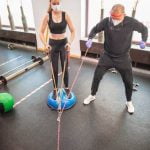Regular exercise is essential for maintaining optimal health and fitness levels. One way to gauge your progress and effectiveness of your workouts is through an exercise bike fitness test score. This score provides valuable insights into your cardiovascular endurance, strength, and overall physical stamina.
An exercise bike fitness test score is a measure of your fitness levels based on your performance during a specific workout routine on the exercise bike. It can help you track improvements over time, set realistic fitness goals, and make necessary adjustments to your exercise regimen.
Monitoring your exercise bike fitness test score can be a motivating factor in staying committed to your fitness journey. By understanding the importance of this score and how it reflects your overall health, you can make informed decisions to improve your physical well-being. In the following sections, we will delve into what an exercise bike fitness test score entails, how to perform the test, factors that influence the score, and tips for enhancing it.
What Is an Exercise Bike Fitness Test Score
An exercise bike fitness test score is a numerical representation of your overall fitness level based on your performance during a specific exercise bike test. This score is calculated by taking into account various factors such as your heart rate, power output, duration of the test, and other relevant metrics. Essentially, it helps quantify how well you are able to perform on an exercise bike and gives you a benchmark to track your progress over time.
One common method used to determine an exercise bike fitness test score is the VO2 max test, which measures the maximum amount of oxygen your body can utilize during intense exercise. The higher your VO2 max, the better your cardiovascular endurance and overall fitness level. Other tests may focus on power output, speed, or resistance levels to assess different aspects of your physical capabilities.
Monitoring your exercise bike fitness test score regularly can provide valuable insights into the effectiveness of your training program and help you set realistic goals for improvement. By tracking changes in your score over time, you can identify areas that need attention and make adjustments to your workouts accordingly. Additionally, seeing tangible progress in your fitness test results can be a great source of motivation to keep pushing yourself during each workout session.
| Exercise Bike Fitness Test Score Benefits | Details |
|---|---|
| Quantifies overall fitness level | Provides benchmark for progress tracking |
| Insights into training program effectiveness | Motivation for continuous improvement |
Benefits of Monitoring Your Exercise Bike Fitness Test Score
Monitoring your exercise bike fitness test score can provide valuable insights into your overall health and fitness level. By understanding what this score represents and how it can impact your well-being, you can make informed decisions about your exercise routine and lifestyle choices.
One of the key benefits of monitoring your exercise bike fitness test score is that it serves as a measure of your cardiovascular fitness. This score reflects how efficiently your heart and lungs are able to deliver oxygen to your muscles during physical activity. By tracking changes in this score over time, you can gauge improvements in your cardiovascular endurance and track your progress towards reaching fitness goals.
Additionally, keeping an eye on your exercise bike fitness test score can help identify any potential health concerns early on. A decline in this score could signal underlying issues such as poor heart health or decreased lung function. By regularly monitoring and addressing changes in your fitness test results, you can take proactive steps to improve your overall health and reduce the risk of developing chronic diseases.
How to Perform an Exercise Bike Fitness Test
Setting Up the Exercise Bike
Before performing an exercise bike fitness test, it is essential to ensure that the bike is set up correctly. Adjust the seat height so that your legs are slightly bent at the lowest point of the pedal stroke. Make sure the handlebars are at a comfortable distance and height for your reach. Additionally, check that the resistance on the bike is set to an appropriate level for the test.
Warm-Up Routine
Prior to starting the fitness test, it is crucial to engage in a proper warm-up routine. Spend about 5-10 minutes pedaling at a moderate intensity to gradually increase your heart rate and warm up your muscles. This will help prepare your body for the intensity of the test and reduce the risk of injury.
Performing the Fitness Test
There are various protocols for conducting an exercise bike fitness test, with one common method being a submaximal or maximal effort test where you pedal at a steady pace for a set duration or until exhaustion. Monitor your heart rate throughout the test, either manually or by using a heart rate monitor, to gauge your cardiovascular fitness level accurately.
Record data such as time elapsed, distance covered, and average heart rate during the test to calculate your exercise bike fitness test score accurately.
By following these steps and dedicating yourself to regular exercise bike fitness tests, you can track your progress over time and make informed decisions about adjusting your workout routine to improve your overall health and fitness level. Remember that consistency and commitment are key factors in achieving lasting results in enhancing your exercise bike fitness test score.
Factors That Influence Your Exercise Bike Fitness Test Score
When it comes to gauging your fitness level through an exercise bike fitness test, there are several key factors that can influence your overall score. Understanding these factors can help you not only improve your performance but also optimize your workouts for better results. Here are some of the main factors that play a role in determining your exercise bike fitness test score:
- Cardiovascular Endurance: One of the primary factors that impact your fitness test score is your cardiovascular endurance. This refers to the ability of your heart and lungs to deliver oxygen to your muscles during prolonged exercise. The higher your cardiovascular endurance, the better you’ll perform on the test.
- Muscular Strength and Endurance: Another crucial factor is your muscular strength and endurance, particularly in the lower body muscles used during cycling. Stronger leg muscles will allow you to pedal at a faster pace and resist fatigue, ultimately improving your test score.
- Body Composition: Your body composition, including muscle mass and body fat percentage, can also influence your exercise bike fitness test score. Carrying excess weight or having a higher body fat percentage may hinder your performance on the test.
In addition to these main factors, other variables such as hydration levels, nutrition, rest days between workouts, and even psychological factors like motivation and focus can all impact how well you do on an exercise bike fitness test. By paying attention to these influencing factors and making adjustments as needed, you can work towards achieving a higher fitness test score and improving your overall health and wellness.
- So, next time you hop on an exercise bike for a fitness test, consider how these influencing factors may be playing a role in your performance. By addressing areas of weakness and focusing on building strengths, you can gradually see improvements in your exercise bike fitness test scores over time.
- To effectively track these changes, it’s essential to perform regular fitness tests using the same protocols each time. This consistency will allow you to monitor progress accurately and make adjustments to your workout routine as needed.
- Remember that improving your exercise bike fitness test score isn’t just about achieving a number on a screen-it’s about challenging yourself, setting goals for improvement, and ultimately reaping the rewards of increased physical fitness and overall well-being.
Interpreting Your Exercise Bike Fitness Test Score Results
Once you have completed the exercise bike fitness test, it is essential to understand how to interpret the results. Your fitness test score can provide valuable insights into your current physical condition and help you track your progress over time.
Typically, the exercise bike fitness test score measures various parameters such as heart rate, power output, distance covered, and duration of the workout. These metrics are used to calculate your overall fitness level and provide an indication of your cardiovascular endurance and muscular strength.
For instance, if your exercise bike fitness test score shows an increased power output or a lower heart rate compared to previous tests, it could indicate that your fitness has improved. On the other hand, a decreased distance covered or shorter workout duration may suggest a decline in physical condition. By understanding these results, you can tailor your workout routine to address specific areas for improvement.
| Parameters | Interpretation |
|---|---|
| Increased Power Output | Improved Fitness Level |
| Lower Heart Rate | Enhanced Cardiovascular Endurance |
| Decreased Distance Covered | Possible Decline in Physical Condition |
In addition to looking at individual metrics, it is crucial to consider how these factors interact with each other to get a comprehensive picture of your overall fitness. Consulting with a fitness professional or healthcare provider can also help you better interpret your exercise bike fitness test score results and create an effective plan for achieving your health and wellness goals.
Tips for Improving Your Exercise Bike Fitness Test Score
Regularly monitoring and improving your exercise bike fitness test score is crucial for tracking your progress and reaching your fitness goals. Here are some tips to help you enhance your exercise bike fitness test score:
- Consistent Training: Consistency is key when it comes to improving your exercise bike fitness test score. Set a regular workout schedule and stick to it, aiming for at least 30 minutes of moderate to intense cycling each session.
- Vary Your Workouts: Incorporating different types of workouts, such as interval training or hill climbs, can challenge your body in new ways and improve your overall cardiovascular fitness. Mix up the intensity and duration of your rides for optimal results.
- Proper Form: Pay attention to your posture and technique while cycling on the exercise bike. Maintain a neutral spine, engage your core muscles, and adjust the seat height to ensure proper alignment. This will not only prevent injuries but also maximize the efficiency of your workout.
In addition to these tips, focusing on proper nutrition, staying hydrated, and getting enough rest are essential components of improving your exercise bike fitness test score. Remember that progress takes time, so be patient with yourself and celebrate small victories along the way. By committing to regular training and making healthy lifestyle choices, you’ll see improvements in your fitness test score and overall well-being.
Real-Life Success Stories
Improving your exercise bike fitness test score can have a significant impact on your overall health and well-being. Many individuals have experienced life-changing transformations by committing to boosting their fitness levels through regular exercise and monitoring their fitness test scores. By tracking progress and making adjustments to their routines, these individuals have not only improved their physical health but also enhanced their mental clarity and emotional well-being.
One success story involves Sarah, who decided to take control of her health after receiving a below-average exercise bike fitness test score. Determined to make positive changes, she incorporated regular cycling sessions into her daily routine and focused on improving her cardiovascular endurance.
Over time, Sarah noticed significant improvements in her fitness test score, which motivated her to continue pushing herself to new limits. As a result, she not only achieved a higher fitness level but also gained more energy and confidence in all aspects of her life.
Another inspiring example is John, who struggled with maintaining a healthy weight due to his sedentary lifestyle. After receiving a below-average exercise bike fitness test score during a routine check-up, he made the decision to prioritize his health and well-being. By incorporating consistent biking sessions into his schedule and making healthier food choices, John was able to significantly improve his fitness test score over time.
Not only did he lose weight and build muscle strength, but he also experienced decreased stress levels and improved mental focus throughout his day. Through dedication and perseverance, John’s commitment to improving his fitness test score transformed his life for the better.
These real-life success stories serve as powerful reminders of the impact that focusing on your exercise bike fitness test score can have on your overall quality of life. By setting goals, staying consistent with your workouts, and monitoring your progress through regular fitness tests, you can achieve remarkable results both physically and mentally.
Remember that each improvement in your exercise bike fitness test score is not just a number – it represents your commitment to bettering yourself and living a healthier, more fulfilling life.
Conclusion
In conclusion, the exercise bike fitness test score serves as a crucial metric in assessing one’s cardiovascular health and fitness levels. By regularly monitoring this score, individuals can gain valuable insights into their progress and make necessary adjustments to their workout routines. The benefits of understanding and improving your exercise bike fitness test score are numerous, from enhancing overall physical performance to reducing the risk of chronic diseases.
Committing to regular fitness tests using an exercise bike is essential for optimal health and fitness outcomes. By consistently evaluating your fitness levels through these tests, you can track your progress, set realistic goals, and stay motivated on your wellness journey. Moreover, regular exercise bike fitness tests can help individuals identify any potential health concerns early on and take proactive steps to address them.
Ultimately, by prioritizing regular fitness tests and actively working towards improving your exercise bike fitness test score, you are investing in your long-term well-being. Remember that every effort you put into enhancing your cardiovascular health and fitness levels will pay off in the form of increased energy, strength, and overall quality of life. So, embrace the process of self-assessment through exercise bike fitness testing as a tool for achieving optimal health and wellness.
Frequently Asked Questions
What Is a Good Resistance on a Stationary Bike?
A good resistance on a stationary bike can vary depending on individual fitness levels and goals. Generally, a moderate resistance that challenges your muscles without causing strain or discomfort is ideal for most people.
What Is a Good Fitness Test Score?
A good fitness test score is typically one that falls within the average range for your age group and gender. It indicates that you have a reasonable level of cardiovascular endurance, strength, flexibility, and overall health.
What Is Considered Fast on a Stationary Bike?
What is considered fast on a stationary bike depends on factors such as your fitness level and the intensity of your workout. Generally, cycling at a speed that pushes your limits and elevates your heart rate significantly would be considered fast.

Passionate about providing useful information to anyone with an interest in the field of Personal Training, I strive to pass on to our readers quality information and to answer any questions about Personal Trainers, the work they do and how to become one.





